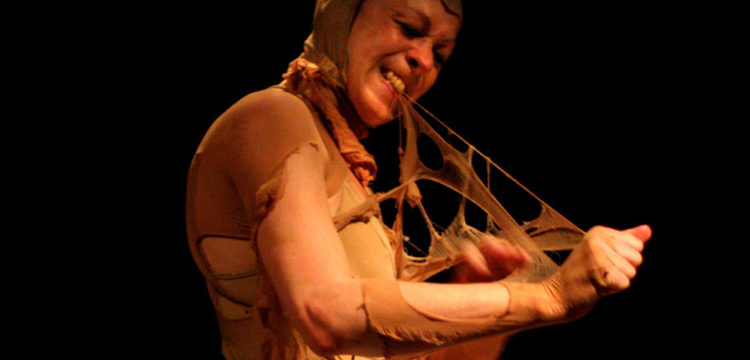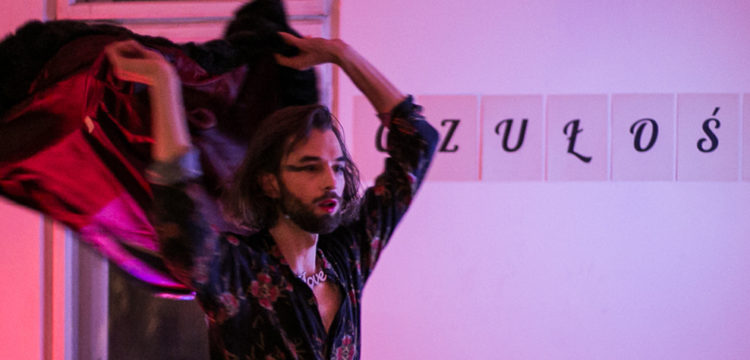Dance Back to the Roots
Nora Chipaumire on the black performing body, dance, art and aesthetics
#PUNK 100% POP *N!GGA (hashtag punk, one hundred percent pop, star nigga) is a three-part live performance album inspired by Nora Chipaumire’s formative years in Zimbabwe and the energy and rebellion of punk and 1980s New Wave music. Each part explores one of three sonic ideologies: Punk, Pop and Congolese Rumba (in that order), which are confronted and celebrated through music artist Patti Smith, Grace Jones and Rit Nzele. Each session exists as a complete statement and can be performed separately (like a single song) or together as an epic song cycle (like an album). Together, the trio paints a sonic and visual landscape, engaging voice, gesture and sound clash installation.
Chipaumire is currently touring #PUNK 100%POP *NIGGA, the three-part live performance album which had its full world premiere at The Kitchen in NYC in October 2018. Her current and ongoing work includes a digital book project, nhaka, a theory, technology, practice and process to her artistic work. Her upcoming work will be an opera entitled Nehanda (2020). Chipaumire is a 2018 Guggenheim fellow and a three-time Bessie Award winner.
Nora Chupaumire recently performed #PUNK at Palazzo Grassi in Venice. Punk, a slang for a worthless person, became the name for a loud, the fast moving form of rock music that became popular in the 70s and 80s. The punk cultural aesthetics include a diverse array of ideologies (such as self-reliance, non-commercial art-making, non-complacency, destroying and re-purposing, etc.) expressed through fashion, visual art, dance, cinema and literature. The way the visual installation is recycled and transformed by the performers and audience reflects these ideologies. In her iconic song Rock ‘n’ Roll Nigger, Patti Smith declares “I haven’t fucked much with the past, but I fuck plenty with the future.” Spurred by this daring proclamation, I declare myself to be an “African nigger”—who sort of fucks with the past, and fucks even harder with the present/future. Encouraged by the punk rejection of the status quo, ethics and ethos, I am seduced by the possibility that there is no future, that the future is in the present. In #PUNK, I stage a raw concert inspired by indie music, americana and my formative years in Zimbabwe in the 70s and 80s.”
Ginevra Bria: How did dancing and performing shape and mould your womanliness? When did you start dancing and why?
Nora Chipaumire: I do not know when we’ve become women or whether we’ll eventually become women, I really don’t know. I think women are always becoming, their identity is evolving and transforming in time. Women are always in the process of getting something greater, exactly as humans, in a broad sense. I’m now 53 years old and I feel we are constantly re-shaping and re-moulding what we are concerned about—in a correct “gender placement” of being-a-woman. For me, an ownership of responsibilities as well as a constant pushing against our noses are both factors which shape us as women. When you live the dilemma of being both African and a woman, you think it’s incredible to find yourself in Venice when perceiving that, in your life, people always presume to know what being Afro-American means.
I’ve been in the profession of dancing since 1998 and that’s the way I would need to answer in a Western way. Because the Western universe reads dancing as a formal discipline, with training, schools and studios. But on the African continent everybody moves. Now I’m able to answer both ways and I would say, ironically, I’ve been able to be inside of my body in terms of movement since I was born. However, the difference is the way I used movement and sound, as complementary components, as languages defining each other. Before 1998 I was only, happily enjoying dance and its related physical health, deriving from being in constant movement. Yet, from 1998 I’ve become resolutely aware on how to weaponize the gestures. They go beyond where and what language, especially English language, which is not my mother tongue.
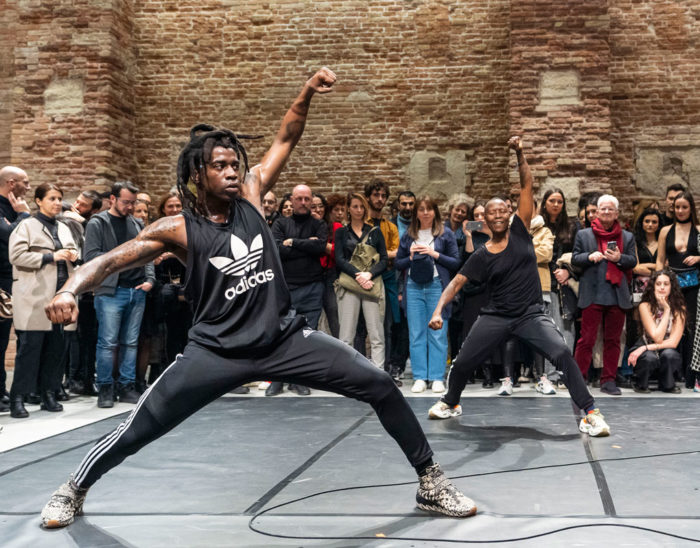
Nora Chipaumire, Set Up, 2020. at punta della dogana. Photo Matteo De Fina.
Once you affirmed “I come from a not industrial culture, where you have to search the best of who you are, what’s valuable” how does your body incarnate contradictions and dissimilarities?
In general, I think every woman is a strong containment of contradictions and tension. All women, wherever they come from, have a certain kind of divine power in keeping contradictory thoughts in one body. Ultimately the constant practice of dissolving those kinds of tensions means to me healing and meditating, as philosophizing. A gaze on how we see the world. The effort of collapsing into a variant and different universe is quite an interesting and meditative practice.
Who is the most inspiring figure, in performative fields, you are tending towards? Why?
I don’t know if it could be revised only a preeminent inspiring figure, in my practice. But I return again and again to the African musicians and masters. The ones who breached the ancient colonial world, leading it toward independence. I’m studying the way they play traditional forms and sounds urbanizing them, as, for instance, Franco Luambo and TPOK jazz masters. They were able to shift us into urban cosmopolitan spaces while retaining the roots of what we are. They are not celebrated enough. I consider myself an eternal student of African music. They are a key, somehow, for understanding how we hold onto our mother tongues, while we keep in step with the rest of the world.
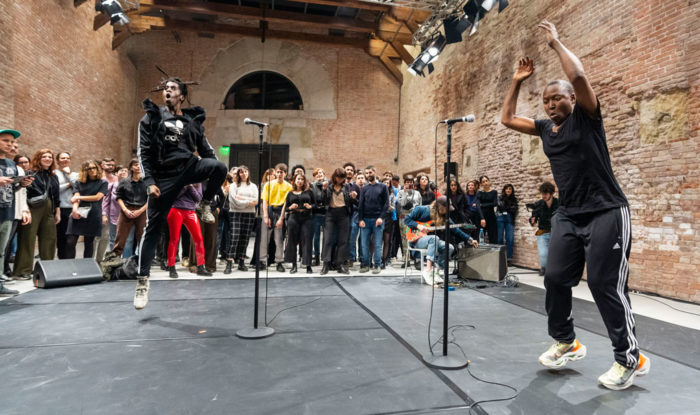
Nora Chipaumire, Set Up, 2020. at punta della dogana. Photo Matteo De Fina.
Could you please define your practice as a nhaka? And how could it be related to a sort of contemporary shamanism?
It’s a mathematical and a logical consequence of what everyone is. In Shona language, nhaka means inheritance, or better, what someone inherits. The definition could belong to a broader way of interpreting what comes from our DNA, exactly as the color of our eyes, of our skins, and even including the person we’ve become, with our own dreams, our imagination or our rhythmic patterns, grown within us. A nhaka definition could also embrace the results of the use of our imagination as part of our work. Also, the things we create could become inheritance, copies translated by others. A constant process of creating a legacy could be considered a contemporary knowledge emersion, no longer a supposed hidden secret as the voodoo science. A way of understanding time and a way of being in space is simply a mathematical energy.
And could it be related to a certain kind of spirituality? Of course, Africa would not be Africa if it could be separated from her inner Animism. This is an important aspect of the nhaka practice: we have to recognize the fact that our bodies are not empty: our body comes into the world full of different agencies, made, for instance, of several adjustments recorded during ancestral environmental changes. The future is also the present: a real timeline is infinitive and it includes past present and future. We must be grounded into the present, but your future thinking will be influenced necessarily by your past. Both future and present are included into a present body, in the now. I’m not trying to reduce the whole African world view into a simple concept. We can use our imagination to bring the future into our present living, we could calculate how we’d like to become, twenty years from now, nurturing a perfect terrain for our spiritual and physical status. The way we think and speak reflects the way we move, the way we calibrate spaces.
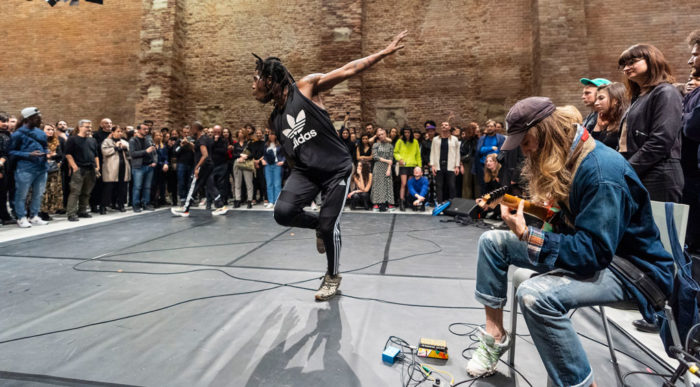
Nora Chipaumire, Set Up, 2020. at punta della dogana. Photo Matteo De Fina.
Dancing could define yourself as a sangoma, as a healer, a cathartic artist?
Whether it’s Vaclav Fomič Nižinskij, Anna Pavlova or any African artist moving, that’s the point of dance and that’s why it is forbidden in some cultures: it’s such a powerful agent. Humans are capable of preserving and transmitting good vibes, transforming it into a cathartic path both for the performer and the audience. This is another matter why people come to see dance and that’s why ancient Christian churches have banned it too: because they knew the power of the body. I would not go as far as to call myself a sangoma, no person could define him or herself like that, it’s an epithet people give to you. I do only believe in my work, that could lead me to an integrity, a sacred world.
How does your Trilogy #PUNK, 100% POP and *N!GGA could represent a prismatic view on female music performed on stage?
I’m trying to capture praises and geniality of black women, as Grace Jones. When the whole, the entire world of being-women it’s investigated through sound it gets larger and more mysterious. Sometimes we have to surrender and believe in faith. Anyway, I’m also trying to find a way and thinking how to end the tour of this trilogy up in Congo, as ultimately it’s where a lot of raw materials are extracted from today—it’s where our progress eventually comes from. I would like to start again in a new world outside Grace Jones, in a world where empowerment finds its energies to mould capitalism. There I could discuss power, through African artists. It’s near and dear to all of us, whether we are animists or not. The trilogy, in itself, could or could not be associated with the Catholic narration. But we are so very much affected by Christian mythologies shaping other religious dogma that we do not recognize other structural forms of encoding reality.
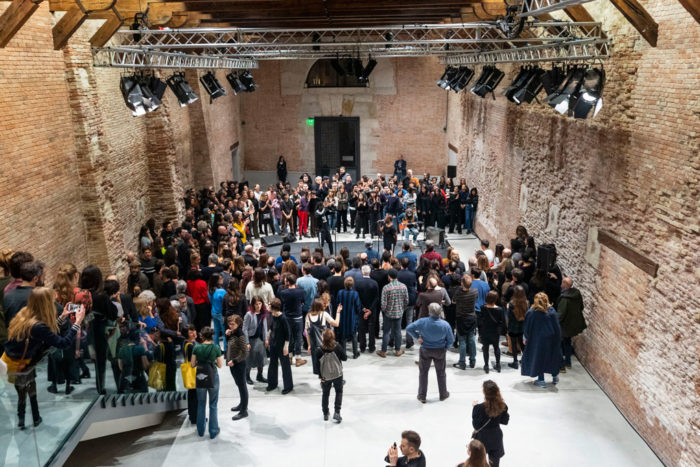
Nora Chipaumire, Set Up, 2020. at punta della dogana. Photo Matteo De Fina.
Which kind of new definition of performative dance do #PUNK, 100% POP and *N!GGA are offering?
The audience is able to feel and sense which kind of new values the Trilogy is offering. Living art, live art is at stake as an organism and I do think it must not be considered as dead. It’s been dead for so long. Dance should agitate—activate space, remind us about the fact that we are living beings. A thinking body could not be stationary, it must always be in trouble with its social, political and aesthetic context. Voice and sound are activated muscularly, there’s no separation between sound, body and movement. Those are some of the issues I am wrestling with. I would like the audience to think for themselves, through the work I’m presenting. In Venice I’m only introducing #PUNK, it’s a choice.
You’ve been performing your Trilogy for almost 2 years now, how did it change in time and which is the venue, or the city which “responded” in the best way? Why? Could you please tell us a few remarkable anecdotes?
We have just been in Helsinki where we performed the Trilogy. Anyway, I would say it could be just a bit unfair to point one city out but it would be New York, which is where we started thus holds a special place. Even though the city is important also for the political situation occurring right now. We revised a complete complicity between the work and its audience, in front of us. In some situations, it’s always nice to be preaching to a choir, but also, in other ways, also in other cities we’ve been, in Europe, people were asking “what’s going on?” and their comments resonated with me. In my opinion, the history of Africa and Europe it’s always in constant collision. The jaw-dropping Europeans showed how profoundly the performance touched different issues and raw nerves, unsolved situations. Every place where we’ve been is remarkable. Even in Rome the show was sold-out, and we sweated our ‘bullets’ in this marvellous building which was the former house of the fascist youth. The connection with history to who and where we are now is extremely important. The less we forget the less we’ll be repeating massive mistakes. We performed in Mali, where the people are almost completely French speaking, and what they could understand were words like lumumba or kurumba and they were screaming every time when they had the chance to hear words echoing their language. The relationship with the audience is necessary: the public is the work.
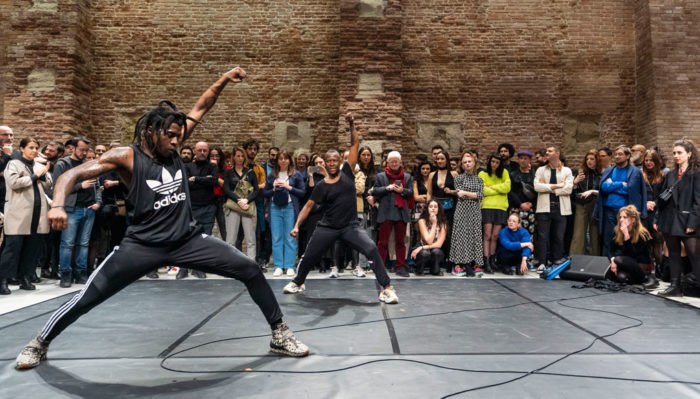
Nora Chipaumire, Set Up, 2020. at punta della dogana. Photo Matteo De Fina.
Could you please explain how the trilogy was born also thanks to Shamar Wayne Watt, Atiyyah Khan, David Gagliardi and Ari Marcopoulos contributions? How did you work together?
I always work by myself first. I have ideas, agitations and politics within me. Because I don’t have clear in my mind other skills beyond my thinking and moving. Then I call on people I had a relationship with from before, for example: David was introduced to me by Ari who was the set designer. Basically, they introduced themselves because they loved my work and then they became friends and then we started to work together. I’m usually very loyal and I love to work with the same people over and over again. I could state that my practice brings people supporting me and enriching it with different cultures, different values or contributions. Dialogues and reciprocal learning allow us always to merge our different perspectives. David, for instance, is a guitarist who has never been to Africa. But he was so intrigued by the proposition of #PUNK that he gave a punk sensibility to his way of playing. And also, he was studying very deeply what rumba Congolese is or means. Atiyyah Khan was a DJ I met when I was in Cape Town, doing researches for #PUNK, and when she came to me, with a record, I understood I had to examine her role better. Hidden aspects of me often lie in other people, amplified, and this can build a better picture of my work. Exactly as Kara Walker did, designing the colossal set of my performance, actually on its way to Lisbon. There’s also Austin Williamson who is a drummer and a percussionist, coming into my world. This work helped me to create and select band members, in order to make a kind of performative music which keeps its integrity.
Could you please express a message, a thought accompanying #PUNK’s spectatorship?
When I was in Venice in 2009, I was stunned how African bodies moved in non-African spaces, enhancing the relationship with their ancestral connection between Europe and Africa. That was a starting point for #PUNK I could never forget. In a way, I’m getting back to my roots here.




